NorthEast Radio Watch 12/15/2025: NYC Morning Shakeup
In this week’s issue… NYC morning shows exit - Carton back amidst WFAN shakeup - FM signing off in Canada - More radio centennials
Text and photos by SCOTT FYBUSH
Our late-summer trip to Boston had one main purpose: to see our friends at WBZ make their big move from Allston up to Medford. (Which we did, and chronicled here and here for RadioInsight’s new Technology section.)
But in between those visits, we caught up with many of our other broadcast friends from our years in Boston – and since your editor has been in the public broadcasting world for many years now, it was only natural to go see what was up with the big public stations in Boston.
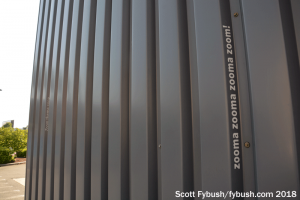
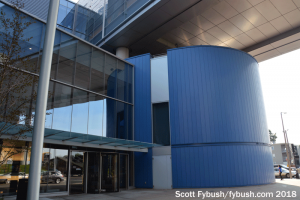
All the time I was working at WBZ, WGBH was one of our closest broadcast neighbors, down Western Avenue in the complex of buildings it had occupied since the mid-1960s when it rebuilt after the huge fire that destroyed its original Cambridge home.
In 2007, WGBH made a very big move across Allston, relocating to a massive new facility overlooking the Mass Pike at the corner of Guest Street and Market Street, where it sat right between two big commercial radio clusters, Entercom in the New Balance Building a block down Guest Street and CBS Radio just across Market Street at Leo Birmingham Parkway.
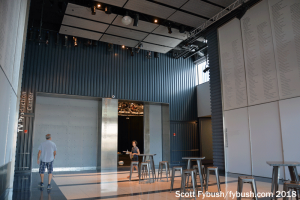
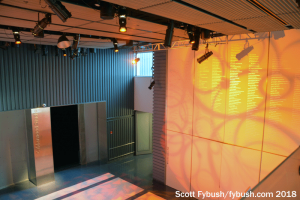
We’d been in the new WGBH building just as it was opening, but it had been a while, and so it was nice to get the full tour in two installments, once with the engineers on the radio side (most of whom I’d worked with back at WBZ in the day) and then later on with the TV side.
Park in the guest spaces behind the building off Guest Street, and if you look closely at the corrugated metal walls along the side of the building as you walk around to the door, you’ll see they’ve been decorated with one-line excerpts of famous public broadcasting theme songs (“Send it to ZOOM!,” “Won’t you be my neighbor?”) and speeches (Newton Minow’s “wires and lights in a box”), making the walk a little more entertaining.
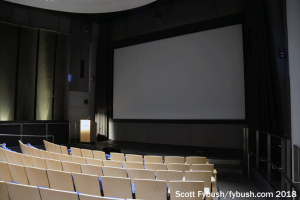
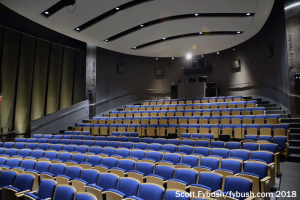
Inside, the lobby opens into a big atrium area that can be rented out for events when it’s not serving as a gathering space for live events taking place in the adjoining public areas. The Yawkey Theater on one side seats several hundred people for screenings and panel discussions, while the Fraser Performance Studio on the other side is a state-of-the-art space that can accommodate a 60-person symphony orchestra for recording sessions.
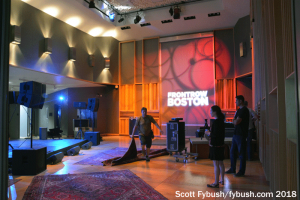
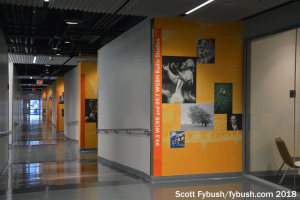
A door just past the Fraser studio entrance seals off the working radio spaces in the building, which stretch down a hallway that parallels Market Street outside.
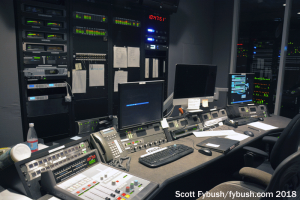
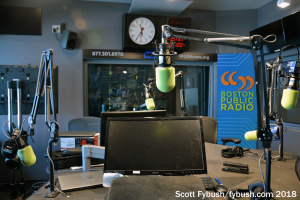
There’s a small radio master control area here where WGBH’s engineers can monitor the main FM 89.7 transmitter up on Great Blue Hill, the WCRB (99.5) classical transmitter up in Andover that we showed you last week, as well as the Cape and Islands stations WGBH runs and the WCRB relay on WJMF down in Rhode Island.
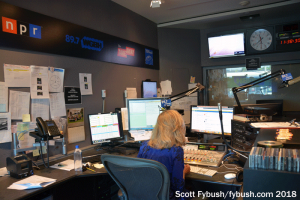
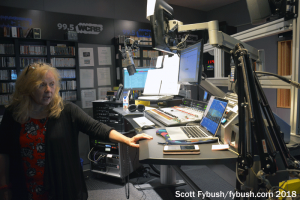
WGBH’s “Boston Public Radio” talk show can originate from a studio and control room here, but it’s often on location down at Copley Square from an open-air studio that WGBH runs in the Boston Public Library’s main building; video links allow the engineers here to watch what’s happening over there.
Local newscasts and breaks come from one of several studios in a row here; across the hall, there’s a separate studio space for classical WCRB, complete with a console on a motorized lift so announcers can work either standing up or sitting down.
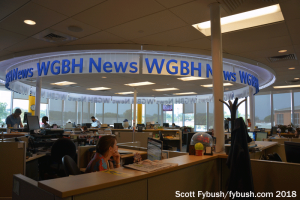
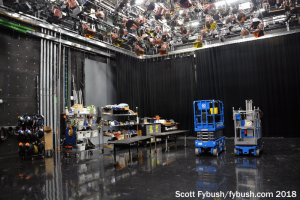
At the end of the radio hallway, on the south side of the building, a big circular newsroom houses the Boston staff for “The World,” the daily news hour that WGBH produces in collaboration with the BBC. There’s more news space now up on the second floor – but for our purposes, let’s go back down the radio hall to the big atrium and walk through the giant doors to the TV side of the first floor. That’s where we find a large studio that’s used for pledge drives and shows that require an audience; it can also be rented out for outside productions.
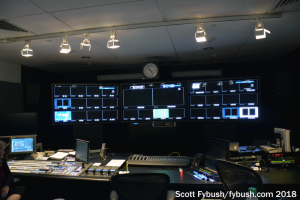
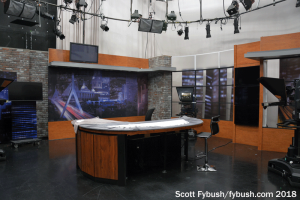
There’s a control room complex down here as well, separating the big studio from a smaller studio that’s partially rental space and, in one corner, home to WGBH’s nightly “Greater Boston” public affairs show (and its addictive Friday incarnation, the media critics of “Beat the Press!”)
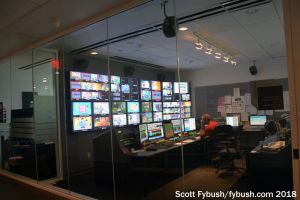
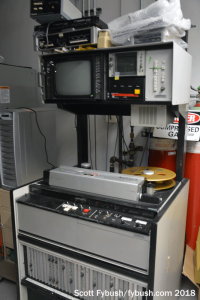
Most of the TV technical plant is upstairs on the second floor, where big glass walls look into an area that began as simply the master control for WGBH’s own TV outlets, WGBH-TV (Channel 2) and WGBX (Channel 44). This area is about to go through some major renovation to handle all the additional use it now gets, because in recent years it’s become home to WGBH’s Public Media Management (PMM) unit, which provides master control, content management, ingest services and much more for a growing roster of public TV stations around the country. (Here’s a story I wrote last year for Current about this operation and its competitors.)
There’s a big rack room area adjoining this room, with lots of state-of-the-art equipment and some vintage gear, too, including a working 2″ quad machine that still gets regular use resurrecting some of WGBH’s huge archive.
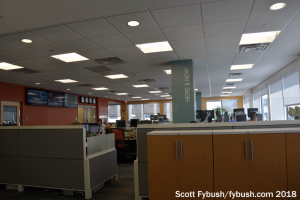
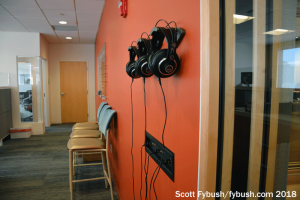
But wait – WGBH is far from the only public media player in this market. On the radio side, Boston University’s WBUR (90.9) began focusing on full-time news and talk while WGBH was still a melange of news, classical and jazz, and it’s become a major national player, collaborating with NPR as producer of national shows such as “Car Talk,” “Only a Game,” “On Point” and “Here and Now.”
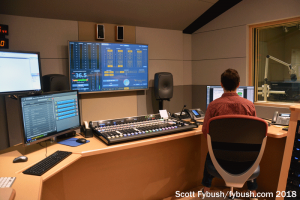
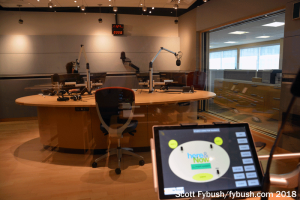
Before we left town in the 1990s, WBUR had moved from its fifties-era studios in the campus communications building on Commonwealth Avenue down the street to the top floor of a BU-owned office building a few blocks to the west. We’d toured those spaces several times, but this time there was something new to see: as WBUR’s operations outgrew the original 890 Comm. Ave. space, the station had recently expanded eastward into the top floor of an adjacent building.
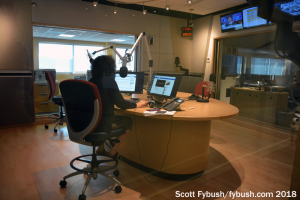
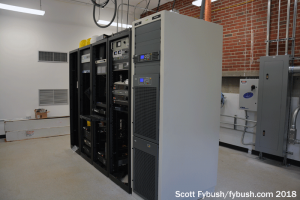
That move opened up plenty of new and much-needed space for several departments: the national shows now have spacious office areas adjoining a lounge that connects to the original building, and around the corner there’s more room for WBUR’s membership and promotions departments.
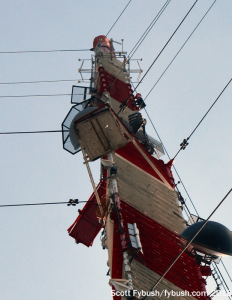
Those areas, in turn, look into a new studio complex that’s used mainly for “Here and Now,” and it’s a beauty – lots of light-colored wood and floor-to-ceiling glass surrounding new Wheatstone consoles in the main control room and the adjoining voice booth/production space.
When guests bring an entourage, there’s space for them now, too: just outside the studio windows, there are stools and headphones where guests can sit and watch interviews being conducted without getting in the way of production staff on the other side of the glass.
And there’s still more that’s new at WBUR: chief engineer Michael Leclair recently finished a big transmitter move, relocating the main 90.9 signal from the FM128 tower in Newton where it’s been for several decades. That former main site is now a full-power backup to WBUR’s new main, a couple of miles away at the big Cedar Street tower that’s home to most of Boston’s TV stations now.
WBUR’s new GatesAir transmitter and Wheatstone processing sit in a very clean, tidy space in a small room behind the old WBZ-TV analog transmitter building (this room was once the WCRB 102.5 transmitter room, years ago; the current 102.5, WKLB, having moved back to Cedar Street from FM128, now occupies a prefab building nearby.)
Look way up the tower, and there’s the new Shively 6016 four-around panel antenna up near the top; making the move to the new antenna gave WBUR much better coverage to the west, where it’s now more listenable in Worcester than ever before.
Thanks to WGBH’s engineering team and WBUR’s Michael Leclair for the tours!

As we announced a few weeks ago, the 2026 edition of the Tower Site Calendar will be the last.
We began publishing it 25 years ago, and the broadcast landscape is radically different now.
Radio World just ran an excellent article about us if you want to know more.
Once it’s gone, that’s it. We won’t be printing any more.
Thank you to everyone who saw our announcement and rushed to buy it. We appreciate you.
(There are some calendars from previous years if you want more of a tower photo fix — all under $5.)
But don’t wait to get this year’s Tower Site Calendar — buy it now!
We are selling the Broadcast Historian’s Calendar again this year, but we have that in an even smaller quantity — definitely don’t hesitate for that.
And visit the Fybush Media Store to check out our selection of books and videos, too!
And don’t miss a big batch of Boston IDs next Wednesday, over at our sister site, TopHour.com!
Next week: Rhode Island and vicinity, summer 2018
In this week’s issue… NYC morning shows exit - Carton back amidst WFAN shakeup - FM signing off in Canada - More radio centennials
In this week’s issue… Veteran newsman returns - Remembering NY's Leitner, RI's Jones - CT AM saved - Maine AM moves - "Indie" adds suburban signals
In this week’s issue… Scripps stations face takeover - Sinclair moves more affiliations - CT stations sold - Maine AM surrendered - Remembering WVBR's Shapiro, WABC's Morgan
In this week’s issue… CT TV legend succumbs to cancer - Remembering PA's Adams - FCC still stalled by shutdown - Pittsburgh morning host exits